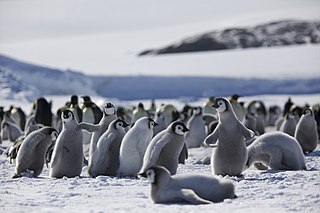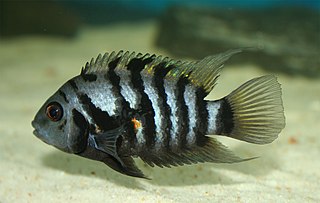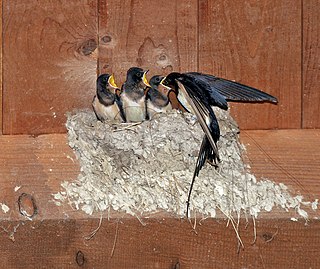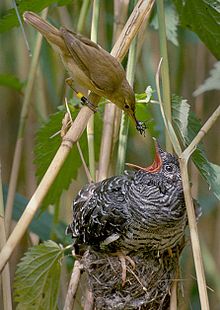
Behavioral ecology, also spelled behavioural ecology, is the study of the evolutionary basis for animal behavior due to ecological pressures. Behavioral ecology emerged from ethology after Niko Tinbergen outlined four questions to address when studying animal behaviors: What are the proximate causes, ontogeny, survival value, and phylogeny of a behavior?

Helpers at the nest is a term used in behavioural ecology and evolutionary biology to describe a social structure in which juveniles and sexually mature adolescents of either one or both sexes remain in association with their parents and help them raise subsequent broods or litters, instead of dispersing and beginning to reproduce themselves. This phenomenon was first studied in birds where it occurs most frequently, but it is also known in animals from many different groups including mammals and insects. It is a simple form of co-operative breeding. The effects of helpers usually amount to a net benefit, however, benefits are not uniformly distributed by all helpers nor across all species that exhibit this behaviour. There are multiple proposed explanations for the behaviour, but its variability and broad taxonomic occurrences result in simultaneously plausible theories.

Parental investment, in evolutionary biology and evolutionary psychology, is any parental expenditure that benefits offspring. Parental investment may be performed by both males and females, females alone or males alone. Care can be provided at any stage of the offspring's life, from pre-natal to post-natal.
In biology, altruism refers to behaviour by an individual that increases the fitness of another individual while decreasing their own. Altruism in this sense is different from the philosophical concept of altruism, in which an action would only be called "altruistic" if it was done with the conscious intention of helping another. In the behavioural sense, there is no such requirement. As such, it is not evaluated in moral terms—it is the consequences of an action for reproductive fitness that determine whether the action is considered altruistic, not the intentions, if any, with which the action is performed.

The convict cichlid is a fish species from the family Cichlidae, native to Central America, also known as the zebra cichlid. Convict cichlids are popular aquarium fish and have also been the subject of numerous studies on fish behaviour.
Cooperative breeding is a social system characterized by alloparental care: offspring receive care not only from their parents, but also from additional group members, often called helpers. Cooperative breeding encompasses a wide variety of group structures, from a breeding pair with helpers that are offspring from a previous season, to groups with multiple breeding males and females (polygynandry) and helpers that are the adult offspring of some but not all of the breeders in the group, to groups in which helpers sometimes achieve co-breeding status by producing their own offspring as part of the group's brood. Cooperative breeding occurs across taxonomic groups including birds, mammals, fish, and insects.

Paedophagy in its general form is the feeding behaviour of fish or other animals whose diet is partially, or primarily the eggs or larvae of other animals. However, P. H. Greenwood, who was the first to describe paedophagia, defines it to be a feeding behaviour evolved among cichlid fishes.

In animals, infanticide involves the intentional killing of young offspring by a mature animal of the same species. Animal infanticide is studied in zoology, specifically in the field of ethology. Ovicide is the analogous destruction of eggs. The practice has been observed in many species throughout the animal kingdom, especially primates but including microscopic rotifers, insects, fish, amphibians, birds and mammals. Infanticide can be practiced by both males and females.

Parental care is a behavioural and evolutionary strategy adopted by some animals, involving a parental investment being made to the evolutionary fitness of offspring. Patterns of parental care are widespread and highly diverse across the animal kingdom. There is great variation in different animal groups in terms of how parents care for offspring, and the amount of resources invested by parents. For example, there may be considerable variation in the amount of care invested by each sex, where females may invest more in some species, males invest more in others, or investment may be shared equally. Numerous hypotheses have been proposed to describe this variation and patterns in parental care that exist between the sexes, as well as among species.

The southern pied babbler is a species of bird in the family Leiothrichidae, found in dry savannah of Botswana, Namibia, South Africa, and Zimbabwe.

Neolamprologus pulcher is a species of cichlid endemic to Lake Tanganyika where it prefers locations with plenty of sedimentation. The common names for N. pulcher include daffodil cichlid, fairy cichlid, princess of Zambia and lyretail cichlid. This species can reach a length of 10 centimetres (3.9 in) TL. It can also be found in the aquarium trade.
Mate desertion occurs when one or both parents abandon their current offspring, and thereby reduce or stop providing parental care. Often, by deserting, a parent attempts to increase breeding opportunities by seeking out another mate. This form of mating strategy behavior is exhibited in insects, birds and mammals. Typically, males are more likely to desert, but both males and females have been observed to practice mate desertion.
Allomothering, allomaternal infant care/handling, or non-maternal infant care/handling is performed by any group member other than the mother. Alloparental care is provided by group members other than the genetic father or the mother and thus is distinguished from parental care. Both are widespread phenomena among social insects, birds and mammals.

Egg tossing or egg destruction is a behavior observed in some species of birds where one individual removes an egg from the communal nest. This is related to infanticide, where parents kill their own or other's offspring. Egg tossing is observed in avian species, most commonly females, who are involved with cooperative breeding or brood parasitism. Among colonial non-co-nesting birds, egg-tossing is observed to be performed by an individual of the same species, and, in the case of brood parasites, this behavior is done by either the same or different species. The behavior of egg tossing offers its advantages and disadvantages to both the actor and recipient.

Infanticide is the termination of a neonate after it has been born, and in zoology this is often the termination or consumption of newborn animals by either a parent or an unrelated adult. In rodents, it is not uncommon for the mother to commit infanticide shortly after parturition under conditions of extreme stress, or for an unrelated male to kill neonates.
Filial cannibalism occurs when an adult individual of a species consumes all or part of the young of its own species or immediate offspring. Filial cannibalism occurs in many species ranging from mammals to insects, and is especially prevalent in various species of fish. The exact evolutionary purpose of the practice in those species is unclear and debated among zoologists, though there is consensus that it may have, or may have had at some point in species' evolutionary history, certain evolutionary and ecological implications.
Polyandry in fishes is a mating system where females mate with multiple males within one mating season. This type of mating exists in a variety of animal species. Polyandry has been found in both oviparous and viviparous bony fishes and sharks. General examples of polyandry occur in fish species, such as green swordtails and Trinidadian guppies. Specific types of polyandry have also been classified, such as classical polyandry in pipefish cooperative polyandry in cichlids and convenience polyandry in sharks.

In behavioral ecology, polyandry is a class of mating system where one female mates with several males in a breeding season. Polyandry is often compared to the polygyny system based on the cost and benefits incurred by members of each sex. Polygyny is where one male mates with several females in a breeding season . A common example of polyandrous mating can be found in the field cricket of the invertebrate order Orthoptera. Polyandrous behavior is also prominent in many other insect species, including the red flour beetle and the species of spider Stegodyphus lineatus. Polyandry also occurs in some primates such as marmosets, mammal groups, the marsupial genus' Antechinus and bandicoots, around 1% of all bird species, such as jacanas and dunnocks, insects such as honeybees, and fish such as pipefish.

Allofeeding is a type of food sharing behaviour observed in cooperatively breeding species of birds. Allofeeding refers to a parent, sibling or unrelated adult bird feeding altricial hatchlings, which are dependent on parental care for their survival. Allofeeding also refers to food sharing between adults of the same species. Allofeeding can occur between mates during mating rituals, courtship, egg laying or incubation, between peers of the same species, or as a form of parental care.
Vertebrate maternal behavior is a form of parental care that is specifically given to young animals by their mother in order to ensure the survival of the young. Parental care is a form of altruism, which means that the behaviors involved often require a sacrifice that could put their own survival at risk. This encompasses behaviors that aid in the evolutionary success of the offspring and parental investment, which is a measure of expenditure exerted by the parent in an attempt to provide evolutionary benefits to the offspring. Therefore, it is a measure of the benefits versus costs of engaging in the parental behaviors. Behaviors commonly exhibited by the maternal parent include feeding, either by lactating or gathering food, grooming young, and keeping the young warm. Another important aspect of parental care is whether the care is provided to the offspring by each parent in a relatively equal manner, or whether it is provided predominantly or entirely by one parent. There are several species that exhibit biparental care, where behaviors and/or investment in the offspring is divided equally amongst the parents. This parenting strategy is common in birds. However, even in species who exhibit biparental care, the maternal role is essential since the females are responsible for the incubation and/or delivery of the young.


















